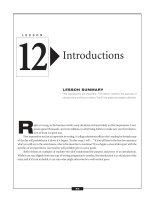General Introduction
Bạn đang xem bản rút gọn của tài liệu. Xem và tải ngay bản đầy đủ của tài liệu tại đây (57.99 KB, 10 trang )
P1: KAF
0521835356agg.xml CY335B/Dembski 0 521 82949 6 March 9, 2004 21:8
1
General Introduction
William A. Dembski and Michael Ruse
Intelligent Design is the hypothesis that in order to explain life it is necessary
to suppose the action of an unevolved intelligence. One simply cannot ex-
plain organisms, those living and those long gone, by reference to normal
natural causes or material mechanisms, be these straightforwardly evolu-
tionary or a consequence of evolution, such as an evolved extraterrestrial
intelligence. Although most supporters of Intelligent Design are theists of
some sort (many of them Christian), it is not necessarily the case that a com-
mitment to Intelligent Design implies a commitment to a personal God or
indeed to any God that would be acceptable to the world’s major religions.
The claim is simply that there must be something more than ordinary natu-
ral causes or material mechanisms, and moreover, that something must be
intelligent and capable of bringing about organisms.
Intelligent Design does not speculate about the nature of such a de-
signing intelligence. Some supporters of Intelligent Design think that this
intelligence works in tandem with a limited form of evolution, perhaps even
Darwinian evolution (for instance, natural selection might work on varia-
tions that are not truly random). Other supporters deny evolution any role
except perhaps a limited amount of success at lower taxonomic levels – new
species of birds on the Galapagos, for instance. But these disagreements
are minor compared to the shared belief that we must accept that nature,
operating by material mechanisms and governed by unbroken natural laws,
is not enough.
To say that Intelligent Design is controversial is to offer a truism. It is op-
posed, often bitterly, by the scientific establishment. Journals such as Science
and Nature would as soon publish an article using or favourable to Intelligent
Design as they would an article favourable to phrenology or mesmerism –
or, to use an analogy that would be comfortable to the editors of those
journals, an article favourable to the claims of the Mormons about Joseph
Smith and the tablets of gold, or favourable to the scientific creationists’
claims about the coexistence of humans and dinosaurs. Recently, indeed,
3
P1: KAF
0521835356agg.xml CY335B/Dembski 0 521 82949 6 March 9, 2004 21:8
4
William A. Dembski and Michael Ruse
the American Association for the Advancement of Science (the organization
that publishes Science) has declared officially that in its opinion Intelligent
Design is not so much bad science as no science at all and accordingly has
no legitimate place in the science classrooms of the United States.
Once one leaves the establishment and moves into the more popular
domain, however, one finds that the level of interest in and sympathy for
Intelligent Design rises rapidly. Many people think that there may well be
something to it, and even those who are not entirely sure about its merits
think that possibly (or probably) it is something that should be taught in
schools, alongside more conventional, purely naturalistic accounts of ori-
gins. Students should be exposed to all sides of the debate and given a
choice. That, after all, is the American Way – open debate and personal
decision.
The editors of this volume, Debating Design: Darwin to DNA, fall at opposite
ends of the spectrum on the Intelligent Design debate. William Dembski, a
philosopher and a mathematician, has been one of the major contributors to
the articulation and theory of Intelligent Design. He has offered analyses of
design itself and has argued that no undirected natural process can account
for the information-rich structures exhibited by living matter. Moreover,
he has argued that the very features of living matter that place it beyond
the remit of undirected natural causes also provide a reliable signature of
design. Michael Ruse, a philosopher and historian of science, has long been
an advocate of Darwinian evolution, and has devoted many years to fighting
against those who argue that one must appeal to non-natural origins for
plants and animals. He has appeared in court as an expert witness on behalf
of Darwinism and has written many books on the subject.
For all their differences, the editors share the belief that – if only
culturally – Intelligent Design is a significant factor on the contemporary
landscape and should not be ignored. For the Intelligent Design propo-
nents, it is a major breakthrough in our understanding about the world. For
the Intelligent Design opponents, it is at the least a major threat to the status
quo and something with a real chance of finding its way into classrooms.
The editors also share the belief that, in a dispute such as this, it is important
that the two sides have a real grasp of the opinions of those that they oppose.
Ignorance is never the way to fight error.
There are of course already books that deal with Intelligent Design and
with the arguments of the critics. The editors have themselves contributed
to this literature. We believe, however, that there is virtue in producing one
volume, containing arguments from both sides, in which each side puts for-
ward its strongest case (previous volumes have tended to bias discussion
toward one side over the other). The reader then can quickly and readily
start to grasp the fundamental claims and counterclaims being made. Of
course – and this is obviously an argument that comes more from the es-
tablishment – even doing something like this can be seen as giving one’s
P1: KAF
0521835356agg.xml CY335B/Dembski 0 521 82949 6 March 9, 2004 21:8
General Introduction
5
opponents some kind of status and legitimacy. And there is probably truth
in this. But we do live in a democracy, and we are committed to working
things out without resort to violence or to underhanded strategies, and so,
despite the worries and fears, we have come together hoping that the merits
of such an enterprise will outweigh the negative factors. Those who know
how to do things better will of course follow their own principles.
The collection is divided into four main sections, with a shorter intro-
ductory section. The aim of the introductory section is simply to give the
reader some background, and hence that section contains an overall his-
torical essay by one of the editors, Michael Ruse, on the general history of
design arguments –“The Argument from Design: A Brief History,” and then
a second essay by Angus Menuge on the specific history of the Intelligent
Design movement –“Who’s Afraid of ID? A Survey of the Intelligent Design
Movement.” Although the first author has very strongly negative views on
Intelligent Design and, as it happens, the second author has views no less
strongly favourable, the intent in this introductory section is to present a
background of information without intruding value commentary. The es-
says are written, deliberately, in a nonpartisan fashion; they are intended to
set the scene and to help the reader in evaluating the discussions of the rest
of the volume.
Michael Ruse traces design arguments back to the Greeks and shows
that they flourished in biology down to the eighteenth century, despite the
rethinking of issues in the physical sciences. Then David Hume made his
devastating attack, but still it was not until Charles Darwin in his Origin of
Species (1859) offered a naturalistic explanation of organisms that the design
argument was truly rejected by many. The essay concludes with a discussion
of the post-Darwinian period, showing that many religious people today en-
dorse a “theology of nature” over natural theology. Most important in Ruse’s
discussion is the distinction he draws between the argument to complexity –
the argument that there is something distinctive about the organic world –
and the argument to design – the argument that this complexity demands
reference to a (conscious) designer to provide a full explanation. These are
the issues that define the concerns of this collection.
Next, Angus Menuge provides a short history of the contemporary Intel-
ligent Design movement and considers its future prospects. He notes that
some, such as Barbara Forrest, dismiss the movement as stealth creation-
ism. Menuge, however, finds this designation to be misleading. He argues
that Intelligent Design is significantly different from typical creationist ap-
proaches in its aims, methods, and scope, and that scientists became inter-
ested in design apart from political or religious motivations. Thus he traces
the roots of the Intelligent Design movement not to the political and re-
ligious zeal of anti-evolutionists but to the legitimate scientific critiques of
evolution and origin-of-life studies in the mid-eighties by scientists such as
Michael Denton and Walter Bradley. Yet because criticism by itself rarely
P1: KAF
0521835356agg.xml CY335B/Dembski 0 521 82949 6 March 9, 2004 21:8
6
William A. Dembski and Michael Ruse
threatens a dominant paradigm, the Intelligent Design movement did not
gain prominence until the work of Michael Behe (Darwin’s Black Box, The
Free Press, 1996) and William Dembski (The Design Inference, Cambridge
University Press, 1998). These works outlined a positive program for un-
derstanding design in the sciences. Mengue concludes his essay by noting
that regardless of whether Intelligent Design succeeds in becoming main-
stream science, it is helping scientists to think more clearly about the causal
pathways that account for the emergence of biological complexity.
We move now to the main sections, each of which has four or five con-
tributions. We go from discussions favourable to evolution and critical of
Intelligent Design, to discussions favourable to Intelligent Design and crit-
ical at least of unbroken evolution. The first such section, Darwinism, starts
with a piece by the leading evolutionary biologist Francisco J. Ayala, a former
Catholic priest and a person with great sensitivity to and sympathy for the re-
ligious attitude. In “Design without Designer: Darwin’s Greatest Discovery,”
Ayala makes three claims. First, he claims that Darwin successfully brought
the question of organic origins into the realm of science; second, that Darwin
spoke to and solved successfully the question of complexity or adaptation;
and third, that nevertheless there is something distinctive (something “tele-
ological”) about biological understanding even in the post-Darwinian world.
The reader should refer back to the introductory essay of Michael Ruse to
fit what Ayala is claiming into the division drawn between the argument
to complexity (that Ayala thinks Darwin addresses and solves scientifically)
and the argument to design (that Ayala thinks is now out of science but still
carrying a form of argumentation that transfers over to modern science).
Ayala concludes that science is not the only way of knowing.
Kenneth R. Miller, a scientist and a practicing Roman Catholic, is one
of the strongest critics of Intelligent Design. In his contribution, “The
Flagellum Unspun: The Collapse of ‘Irreducible Complexity,’”Miller takes
aim at one of the most important concepts promoted by Intelligent Design
supporters, namely that of irreducible complexity. Introduced by Michael Behe
in his Darwin’s Black Box, this is a property possessed by certain aspects of or-
ganisms that supposedly could not be produced by unguided natural causes.
It denotes something so overwhelmingly intricate and complex that it defies
normal natural understanding and demands an explanation in terms of in-
telligence. Behe’s prime biological example is of certain motorlike processes
in microorganisms, and Miller’s intent is to show that Behe is mistaken in
his claims (as is Dembski in his support). Note that Miller explicitly asserts
that his naturalistic position is more theologically satisfactory than that of
his opponents.
Elliott Sober is a well-known philosopher whose piece –“The Design Argu-
ment”–is of a general nature. He is concerned to give a theoretical analysis
of design arguments and particularly of arguments of the kind offered by
Archdeacon William Paley (see Ruse’s introductory chapter). He analyses
P1: KAF
0521835356agg.xml CY335B/Dembski 0 521 82949 6 March 9, 2004 21:8
General Introduction
7
matters in terms of likelihood, that is, the idea of which of two hypotheses is
more likely given a particular observation – in Paley’s case, an intelligence
or blind chance given the discovery of a watch. Although Sober does not
want to go all the way with Paley to the inference of a God (certainly not the
Christian God), given his analysis he is more critical than most philosophers
are of Hume’s arguments (especially inasmuch as they are analogical), but
he is also not convinced that one can simply dismiss design arguments once
Darwin appears on the scene. Having said this, however, Sober has little time
for Intelligent Design, which he thinks fails as genuine science with respect
to important properties such as prediction.
Finally in this section we have Robert Pennock, a well-known philoso-
pher and critic of creationism (the author of The Tower of Babel) who argues
that the Intelligent Design movement is built upon problematic religious
assumptions. Considering the writings of Stephen Meyer (one of the con-
tributors to this collection), Pennock takes up the claim that human dignity
(and morality generally) can be justified only if the assumption that man
is created in the image of God is factual. Pennock’s aim is to criticize not
the belief in “the God hypothesis,” but rather the claim to have established
it scientifically as an alternative to evolution. His essay critiques the theo-
logical presuppositions that he finds hidden in Intelligent Design, as well
as the proposition that the design inference, interpreted as a scientific in-
ference to the best explanation, confirms not just theism, but specifically
the Judeo-Christian God. Along the way, Pennock points out problems with
the recurring arguments that supporters of Intelligent Design use in their
lobbying to get their view taught in the public schools.
The second section, Complex Self-Organization, contains pieces by those
who believe that nature itself, simply obeying the laws of physics and chem-
istry without the aid of selection (or with, at best, a very limited contri-
bution by selection), can produce entities showing the kind of complexity
that Darwinians think can be produced only by their mechanism. This idea
of “order for free” (as it has been termed by Stuart Kauffman) has a long
history; its most notable exponent was the early twentieth-century Scottish
morphologist D’Arcy Wentworth Thompson in his On Growth and Form.
The first piece in this section is by Stuart Kauffman himself. Here
Kauffman tries to imagine what it would be like for biologists to develop
what he calls a “general biology.” By a general biology Kauffman means a
general theory of what it means to be alive and of how things that are alive
originated. Kauffman concedes that we don’t at this time possess a general
biology. According to Kauffman, a general biology would consist in princi-
ples that are applicable to all possible forms of life and that uncover their
deep structure. The problem with natural selection, for Kauffman, is not
that it is false or even that it is less than universally applicable. The problem
is that natural selection cannot account for its own success (or, as he states
it more precisely, cannot account for the “smooth fitness landscapes” that









